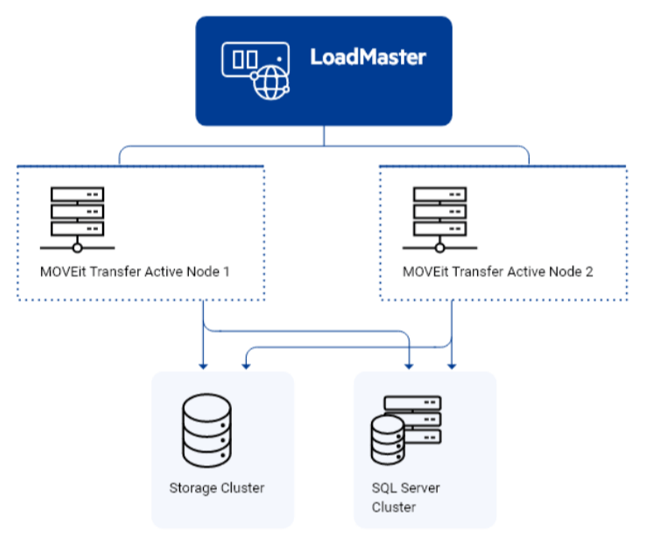Load Balancing offers MOVEit greater scalability, even more security, and unparallel availability for Managed File Transfers. By Doug Barney
Load balancing solutions such as LoadMaster from Progress/Kemp have long taken mission critical apps to new levels with amazing availability, insane scalability, fantastic performance, and security that would make Fort Know proud.
These same attributes can make your file transfers the envy of your competitors (that’s why you shouldn’t tell them your secret).
If you already have load balancing, adding secure file transfer to your IT quiver makes perfect sense. Let’s face it, hackers aren’t giving up on attacking files anytime soon. Instead, attacks against files and the data contained within them are exploding, which is why so many smart enterprises have adopted Managed File Transfer (MFT) solutions such as MOVEit to transfer files reliably and securely throughout the organization and out to business partners of all stripes.
Whether you already have Managed File Transfer or plan to adopt it, load balancing will give that MFT solution unrivalled availability and near limitless scalability. The bottom line: load balancing ensures your secure file transfer solution is an always-on experience for users and the application itself.
With a solution like MOVEit, IT can be confident that file transfers are secure. But that alone is not enough for demanding enterprises. Taking this mission critical application to where it needs to be requires always-on availability and limitless scalability. Enter Progress Kemp LoadMaster. This award-winning load balancer used by enterprises around the world can do for MOVEit what it does for dozens of other enterprises applications – treat it with the mission critical care MFT deserves.
For starters, LoadMaster’s advanced health checking will ensure MOVEit servers are available and ready to accept connections from users and applications. It further properly distributes traffic across the multiple back end MOVEit servers ensuring system resources are appropriately utilized and delivering optimum performance.
Meanwhile, for multi-site deployments, LoadMaster’s Global Server Load Balancing (GSLB) provides automatic failover to an alternate site or cloud in the event of an outage.
LoadMaster combined with MOVEit Transfer and MOVEit Automation delivers an always-on application experience providing a flexible and secure file transfer solution for the enterprise. “I don’t want to be waiting around if I’m in a transaction process and have to upload secure data. It’s bad for experience. MFT should be all about availability, resilience and ensuring the service remains up because now I can withstand a single instance failing,” said Jason Dover, VP of product strategy for Progress/Kemp.
Scalability is also critical for demanding MFT users. “You get to scale a busy system across multiple MOVEit endpoints. That’s where a load balancer helps, because you need an intelligent traffic cop distributing the client traffic across that ecosystem,” Dover explained.

The below diagram shows how the MOVEit/LoadMaster combo works:

Six LoadMaster Advantages
- Deploy Anywhere – Hardware, Virtual, and Cloud load balancing appliance are available.
- Scalability – Hardware appliances with up to 90Gbps throughput to meet the needs for any size deployment.
- High Availability – Deploy multiple LoadMasters to eliminate single points of failure.
- Simplified Configuration – Use the Application Template built for MOVEit to publish with ease using best practices.
- Automation – Automate load balancing configuration using the LoadMaster API, Java, or PowerShell wrapper.
- Multi-Site– Provide multi-site/cloud resilience with LoadMaster Global Server Load Balancing (GSLB).
DNS Not Always the Answer
Some try to implement a form of load balancing through Domain Name System (DNS). While DNS can be used to distribute loads across multiple resources, it is a far from perfect solution for distributing traffic intelligently and consistently. “I can do DNS and have a DNS name pointed at my multiple servers. But what if one of those application servers fail? I need to manually update my DNS records, otherwise every other request is going to fail,” Dover points out.
Load Balancers Do Way More Than the Name Implies
While LoadMaster can boost availability and scalability, there is far more in the LoadMaster quiver. In the mid-90’s when load balancers first appeared, they did fairly low-level traffic distribution. Today, load balancers provide a growing array of functions.
Doing Multi-Site/Multi-Cloud Load Balancing Right
Another key solution is Global Site Load Balancing (GSLB) which is perfect for multi-site or multi-cloud deployment in which IT needs to direct traffic across multiple locations. “For example, I’ve got apps running in the cloud, the public cloud, and on-premises. Let’s say I’m testing my migration to the public cloud and there’s only a select number or select type of requests that I want to send to the cloud location. The GSLB service can help you distribute across multiple sites or multiple cloud ecosystems, and also helps when it comes to site resiliency,” Dover explained. “I may just have a primary and failover site and a site goes down. Do I start directing traffic to site B? The GSLB service monitors the state of both of those sites and when there’s a failure, it starts sending requests to the alternative site.”
Why Zero Trust Matters
LoadMaster supports tight security through Zero Trust. “The load balancer can play a part in zero trust because it doesn’t allow any connections other than those that have been explicitly let through based in how it is configured. You can’t get to anything behind the load balancer until you start defining it,” Dover said. “When you think of load balancers having application services on top, IT can bring in identity validation into the decision-making process. Now load balancing becomes part of the zero trust story.”

